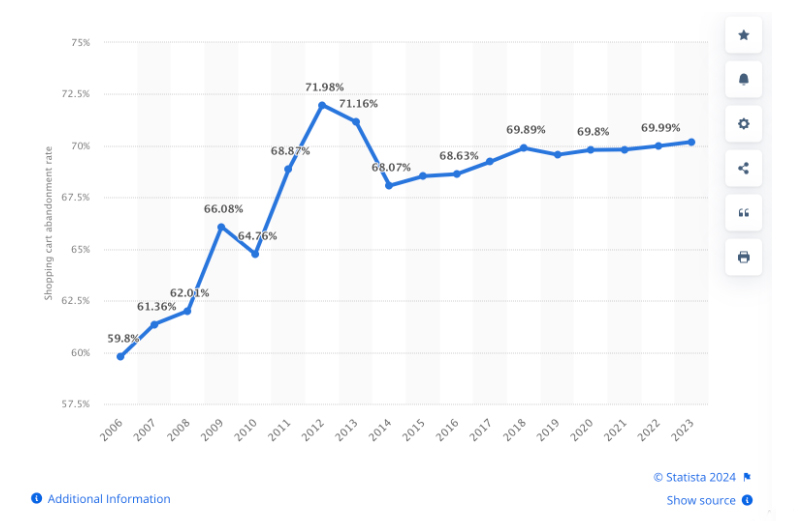10 Changes to Make in Your Ecommerce Website to Reduce Cart Abandonment and Boost Sales
Almost every Ecommerce business has a website that can considerably boost sales. Just having a website and creating high-quality content is not enough. Every Ecommerce website should try to reduce a very common problem of cart abandonment.
Here are some Statisa rates on Online shopping cart abandonment worldwide between 2006 to 2023. From information gathered across 41 various studies on abandoned shopping carts, it’s observed that 69.57% of shoppers exit without making a purchase. This abandonment accumulates, resulting in ecommerce stores losing over $18 billion in annual revenue.
Also Checkout:
- Top 10 Best Coupon Websites in Dubai
- How to Hire the best Website Development Agency in Dubai for your project?
Top 10 Tips and Tricks to Optimize Your Ecommerce Website
How should a business avoid this problem, and can a website be helpful in this situation? Let’s check some changes that will reduce cart abandonment and increase sales, no matter what kind of ecommerce website or business you run.
Let’s move on!
1. Optimize Site Load Speed
Slow-loading pages, especially during checkout, can lead to more people leaving your online store without buying anything. Think about how busy your customers are – if your website is not quick enough, they might leave before finishing their purchase.
Ensure your website works fast, not just on computers but also on smartphones. More and more people are shopping on their phones, which, according to Search Engine Journal, might soon be even more popular than using computers. Many successful online stores are already improving their websites for mobile use. It’s something your store should consider, too.
2. Allow easy access
Facilitate a smoother shopping experience by integrating QR codes into your e-commerce website. These nifty codes offer a swift and effortless way for customers to access products and promptly add them to their carts. The main advantage of QR codes is their simplicity – a quick scan, and the item is in the cart.
This streamlined approach works wonders in diminishing unnecessary hurdles during the buying journey. Picture this: a customer sees a product they like, a simple scan of the QR code, and just like that, it’s on its way to the virtual cart. No fuss, no delays – just a seamless process that enhances your website’s overall ease of shopping.
By creating QR codes, you’re not just simplifying the buying process but also signaling to your customers that their time and convenience matter. In a world where quick and efficient transactions are highly valued, this small yet impactful addition can significantly reduce friction and encourage more successful purchases. So, embrace the simplicity of QR codes and make your customers’ shopping journey all the more enjoyable.
3. Offer a Simple Payment Process
Handling payments might seem complex on the backend, but it should be a quick and effortless task for customers, taking just a moment. The key to minimizing abandonments in this phase is keeping things simple and quick.
Start by ensuring your payment gateway software is dependable. Since folks are still cautious about sharing personal details online, use software prioritizing top-notch security.
Offer your shoppers various payment choices. Let them link up with trusted services like Paypal, Apple Pay, or Amazon Pay so they can skip the hassle of typing in credit card details.
For those going the credit card route, allow them to save their payment info securely for future use. Consider providing flexible payment plans, allowing customers to pay in installments.
4. Add Testimonials and Reviews
Social proof, such as customer reviews and testimonials, is effective in curbing cart abandonment. Introducing a product review section enables potential buyers to peruse testimonials before purchasing, instilling confidence and expediting checkout.
When your product gathers positive reviews, it prompts quicker decision-making and boosts buyer confidence. Extend the reach of these positive reviews through social media advertising, targeting both new and returning customers. By showcasing the positive experiences of others, you not only build trust but also encourage swifter decisions in the buying journey.
5. Create a User-friendly and Mobile-friendly Design
Crafting a user-friendly and mobile-friendly design is pivotal in creating a seamless shopping experience. It’s not just about looking good; it’s about making it easy for your customers to find what they need, especially when using mobile devices.
Ensure your website is a breeze, with clear pathways to products and essential information. Visually, aim for an appealing layout that doesn’t overwhelm the eyes but guides the customer effortlessly.
Why does this matter? Because when your website is user-friendly, customers are more inclined to have a positive experience on it. And when it’s mobile-friendly, it means they can shop conveniently on their phones or tablets, which is increasingly common nowadays.
So, focus on creating a welcoming and straightforward environment – your customers will appreciate it, and your sales may reflect it.
6. Ensure an understandable Return Policy
Ensuring a clear and understandable return policy is crucial for building customer trust. It’s about ensuring they feel secure and informed when purchasing.
Communicate your return policy, outlining the steps and conditions for returning items. This transparency reassures them and contributes to a positive shopping experience.
Consider providing examples or scenarios to illustrate your policy. This helps customers envision how the process works in real-life situations. Remember, an understandable return policy eliminates uncertainty and encourages hesitant buyers to feel more confident about completing their purchase.
By prioritizing clarity and simplicity in your return policy, you’re not just addressing potential concerns but fostering trust and loyalty with your customers. And in online shopping, trust is a key ingredient for success.
7. Utilize Various Payment Methods
Expand your horizons by providing diverse payment options, ensuring you cater to a broad audience. The beauty lies in giving customers the flexibility to choose the method that suits them best. This approach reflects consideration for different preferences and significantly diminishes the likelihood of potential buyers abandoning their carts due to limited payment choices.
8. Tell About Your Products in Detail
Paint a vivid picture for your customers by offering in-depth insights into your products. Share the basics and the nitty-gritty details – specifications, features, and all the benefits. By providing comprehensive product descriptions, you empower customers to make well-informed decisions. This detailed approach serves as a beacon, guiding them through the uncertainties that might otherwise lead to cart abandonment.
9. Accessible Customer Support
Forge a robust customer support system with accessible and reliable customer support. Whether through live chat, email, or a friendly voice on the phone, make assistance readily available. Accessible support doesn’t just resolve queries promptly; it becomes a pillar of confidence for customers. Knowing that help is just a message or call away boosts their trust and encourages them to move forward with their purchase.
10. Limit Distractions
Keep the checkout journey smooth by minimizing distractions – particularly those pesky pop-ups. Unnecessary interruptions can divert attention and, in turn, lead to abandoned carts. Stay concentrated on the buying process. Removing unnecessary interruptions improves the overall user experience, increasing customers’ likelihood of smoothly finalizing their transactions.
Also Checkout:
- 7 Tips to Better Optimize Your WordPress Website in Dubai
- 5 Most Popular Online Money-Making Ideas In Dubai
- 7 Tips to Increase Your Business Social Media Following in Dubai
Conclusion
In the world of ecommerce, addressing cart abandonment is significant for sustained success. Streamlining the user experience through measures like optimizing ecommerce website speed, embracing QR codes for easy access, and simplifying the payment process proves instrumental. Additionally, prioritizing clear communication, accessible customer support, and limiting distractions fosters trust and ensures a seamless journey for customers. By implementing these strategic changes, ecommerce businesses can create an environment that encourages confident purchasing, reduces friction, and ultimately boosts sales.








